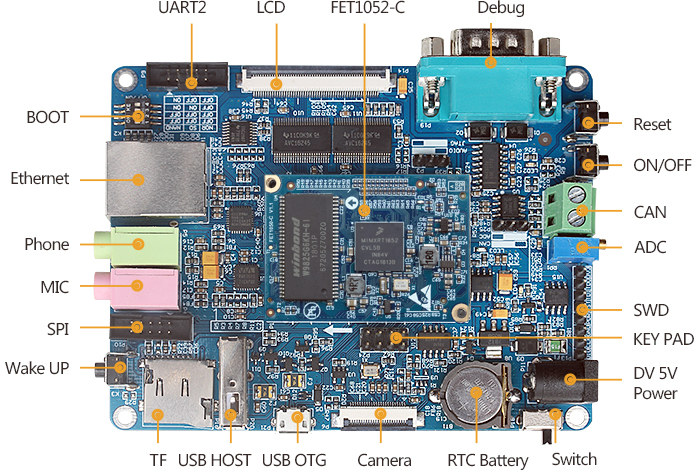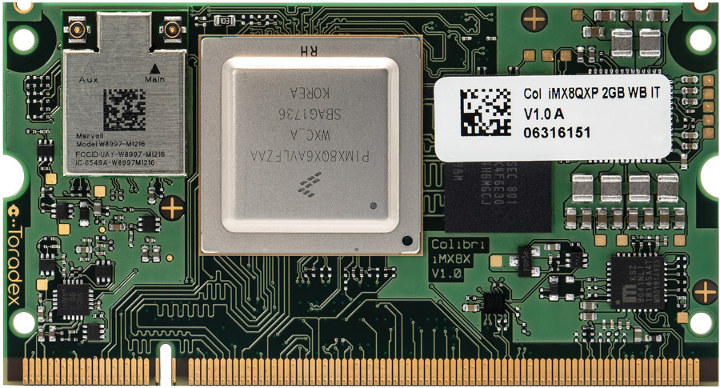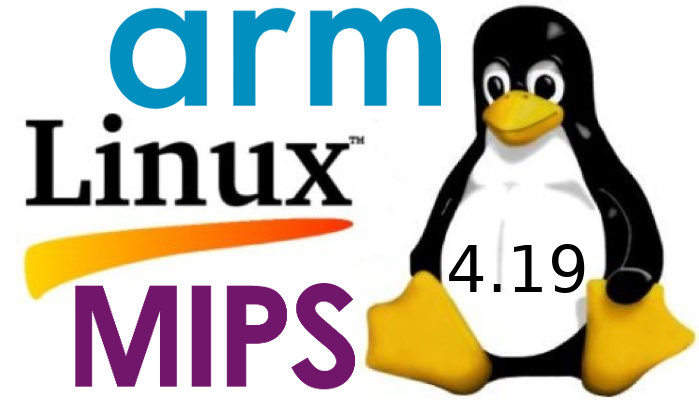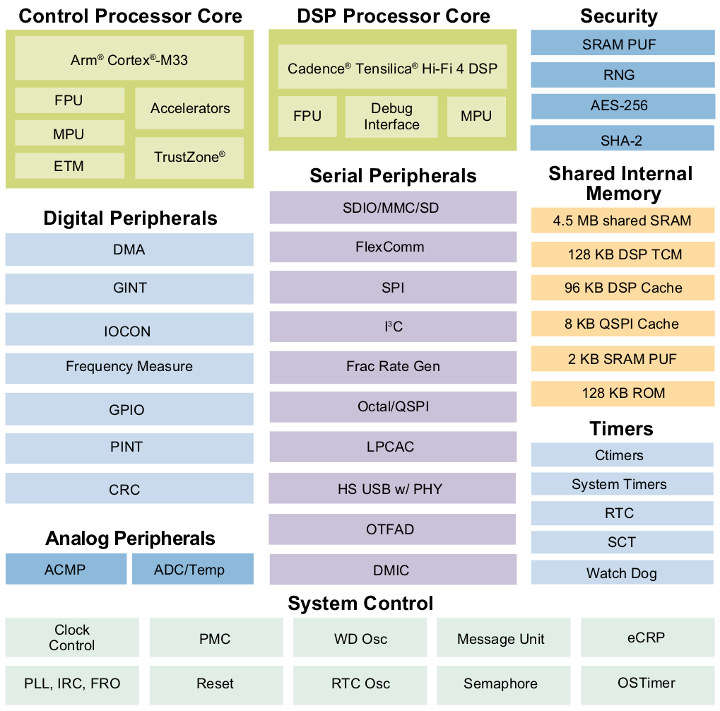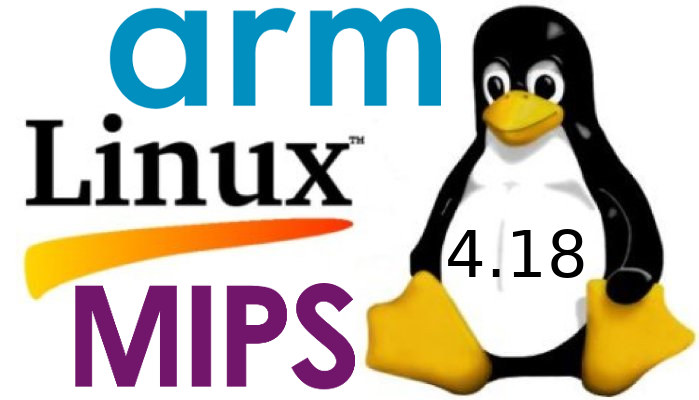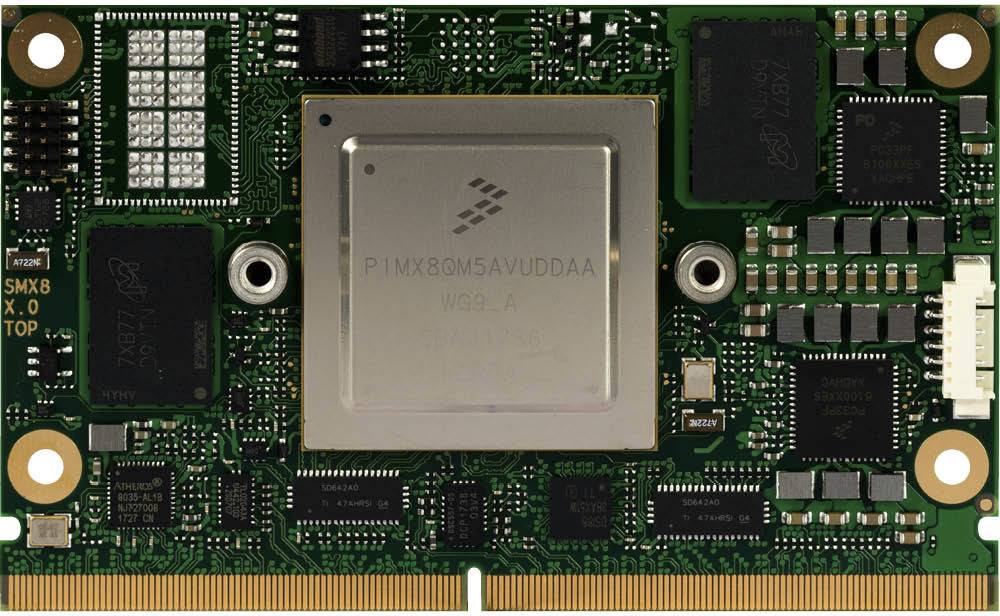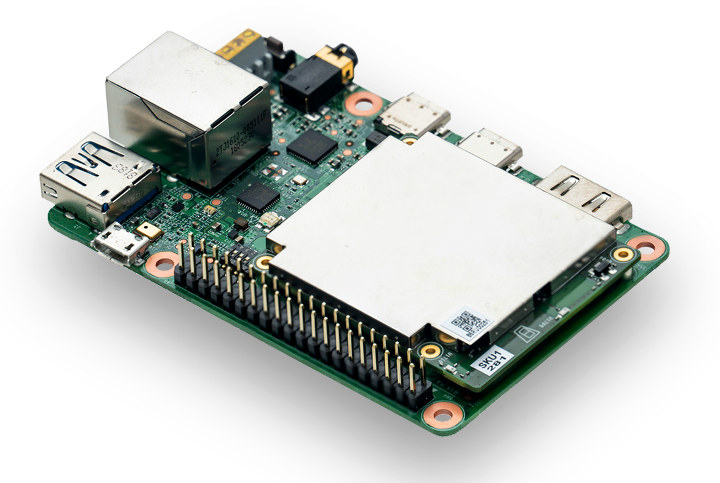A few years ago, various companies tried to develop other Linux based mobile operating systems, but most failed with Mozilla Firefox OS discontinued, Samsung Tizen is not being used in smartphones anymore, and Sailfish OS giving up the consumer market focusing on governmental and corporate customers instead. There’s still a niche market however for privacy-focused, open source Linux smartphones, and we’ve already covered NXP i.MX 8M based Purism Librem 5 smartphone scheduled to launch next year with GNOME based PureOS operating system, and the ability to switch to PureOS with KDE Plasma Mobile or Ubuntu Touch. Necuno Mobile will be another Linux smartphone based on an NXP processor, but instead of relying on a 64-bit i.MX 8M processor, it will be equipped with the older 32-bit i.MX 6Quad processor, and according to the company be “100% open source device, from metal to pixel, from hardware to software”. Necuno Mobile preliminary […]
Forlinx OK1052-C Board Features NXP i.MX RT1052 Crossover Processor
NXP i.MX RT series crossover processors were first announced last year as processors providing the same real-time capability as found in microcontrollers while providing performance similar to entry-level application processors thanks to an Arm Cortex-M7 core clocked at up to 600 MHz. i.MX RT series also lower BoM thanks to integrated PMIC and up to 512KB SRAM/TCM. Later on uCLinux for NXP i.MX RT1050 evaluation board was released, and a few months ago, we covered the upcoming VisionSOM-RT industrial system-on-module powered by the crossover processor. That means we did not have production-ready commercial solutions so far, but this has changed recently, with for example Forlinx Embedded OK1052-C board. The solution is comprised of a baseboard and a system-on-module with the following specifications: FET1052-C SoM SoC – NXP i.MX RT1052 single core Arm Cortex-M7 crossover processor @ up to 528 MHz with 512KB SRAM/TCM System Memory – 16MB or 32MB SDRAM […]
Toradex Colibri iMX8X SoM Features NXP i.MX 8X Dual / Quad Arm Cortex-A35 Processor
Designed for infotainment and dashboard in automotive applications, industrial control, robotics, healthcare, mobile payments, handheld devices, and more, NXP i.MX 8X Arm Cortex-A35 processor was first spotted in 2016, before being formally announced in March 2017. But it took quite longer to see actual products launched, and several vendors announced i.MX 8X modules in the last week while NXP also released documentation. One of them is Toradex with their Colibri iMX8X system-on-module with up to 2GB LPDDR4 memory, 8GB flash, a built-in 802.11ac 2×2 MIMO WiFi + Bluetooth 5 module, dual channel LVDS, MIPI DSI display interface, a quad-lane MIPI CSI-2 camera interface, etc… Toradex Colibri iMX8X specifications: SoC (one of the following options) NXP i.MX 8QuadXPlus quad core Cortex-A35 processor @ up to 1.2GHz, Arm Cortex-M4 MCU @ up to 266MHz, HiFi4 DSP, Vivante GC7000Lite performance optimized GPU, 4K video support NXP i.MX 8DualXPlus dual core Cortex-A35 processor @ […]
Linux 4.19 Release – Main Changes, Arm and MIPS Architectures
With Linus Torvalds taking a leave from the Linux kernel project, Greg Kroah-Hartman was the one to release Linux 4.19 last Sunday: Hi everyone! It’s been a long strange journey for this kernel release… While it was not the largest kernel release every by number of commits, it was larger than the last 3 releases, which is a non-trivial thing to do. After the original -rc1 bumps, things settled down on the code side and it looks like stuff came nicely together to make a solid kernel for everyone to use for a while. And given that this is going to be one of the “Long Term” kernels I end up maintaining for a few years, that’s good news for everyone. A small trickle of good bugfixes came in this week, showing that waiting an extra week was a wise choice. However odds are that linux-next is just bursting so […]
NXP Unveils i.MX RT600 Series Arm Cortex-M33 + Audio DSP Crossover Processor
A little over a year ago, NXP introduces their first crossover processor that blurs the line between real-time capabilities of microcontrollers and higher performance of application processors with NXP i.MX RT1050 processor equipped with a Cortex-M7 core clocked at up to 700 MHz. The company has now announced another model with lower power consumption. NXP i.MX RT600 series comes with a Cortex M33 core clocked at up to 300MHz, a Cadence Tensillica HiFi 4 audio DSP, and up to 4.5MB shared SRAM. Main features of NXP i.MX RT685 crossover processor: CPU Core – Arm Cortex-M33 up to 300 MHz DSP – Tensilica Hi-Fi 4 up to 600 MHz Memory Up to 4.5 MB on-chip RAM 128KB DSP TCM, 128 KB DSP Cache Storage 96KB ROM on-chip 2x SDIO with 1x supporting eMMC5.0 w/ HS400 1x Octal/Quad SPI up to 100MB/s Peripherals 2x DMA Engines with 35 channels each 1x USB […]
Linux 4.18 Release – Main Changes, Arm and MIPS Architecture
Linus Torvalds has just announced the release of Linux 4.18: One week late(r) and here we are – 4.18 is out there. It was a very calm week, and arguably I could just have released on schedule last week, but we did have some minor updates. Mostly networking, but some vfs race fixes (mentioned in the rc8 announment as “pending”) and a couple of driver fixes (scsi, networking, i2c). Some other minor random things (arm crypto fix, parisc memory ordering fix). Shortlog appended for the (few) details. Some of these I was almost ready to just delay to until the next merge window, but they were marked for stable anyway, so it would just have caused more backporting. The vfs fixes are for old races that are really hard to hit (which is obviously why they are old and weren’t noticed earlier). Some of them _have_ been seen in real […]
Congatec conga-SMX8 is a SMARC 2.0 Module Based on NXP i.MX8 Processor
We’ve already seen some SMARC 2.0 SoM based on NXP i.MX8 processor with for instance, i.MX 8M based SECO SM-C12. We now have at more choice thanks to Congatec which just announced conga-SMX8, the company’s first SMARC 2.0 Computer-on-Module based on the NXP i.MX8 Arm Cortex-A53/A72 processor. conga-SMX8 SoM specifications: SoC (one or the other) NXP i.MX8 Quad Max with 2x Arm Cortex-A72, 4x Arm Cortex-A53, 2x Arm Cortex-M4F, 2x Vivante GC7000XSVX GPU NXP i.MX8 QuadPlus with 1x Arm Cortex-A72, 4x Arm Cortex-A53, 2x Arm Cortex-M4F, 2x Vivante GC7000Lite/XSVX GPU NXP i.MX8 DualMax with 2x Arm Cortex-A72, 2x Arm Cortex-M4F, 2x Vivante GC7000Lite/XSVX GPU System Memory – Up to 8 GB LPDDR4 memory | 3200 MT/s Storage – Up to 64GB eMMC flash, micro SD 3.0 card socket Other On-Module Chips 2x Gigabit Ethernet transceiver Optional M.2 1216 WiFi module (soldered down) USB hub 314-pin MXM Edge connector with Storage […]
Google Unveils Edge TPU Low Power Machine Learning Chip, AIY Edge TPU Development Board and Accelerator
Google introduced artificial intelligence and machine learning concepts to hundreds of thousands of people with their AIY projects kit such as the AIY Voice Kit with voice recognition and the AIY Vision Kit for computer vision applications. The company has now gone further by unveiling Edge TPU, its own purpose-built ASIC chip designed to run TensorFlow Lite ML models at the edge, as well as corresponding AIY Edge TPU development board, and AIY Edge TPU accelerator USB stick to add to any USB compatible hardware. Google Edge TPU (Tensor Processing Unit) & Cloud IoT Edge Software Edge TPU is a tiny chip for machine learning (ML) optimized for performance-per-watt and performance-per-dollar. It can either accelerate ML inferencing on device, or can pair with Google Cloud to create a full cloud-to-edge ML stack. In either case, local processing reduces latency, remove the needs for a persistent network connection, increases privacy, and […]


